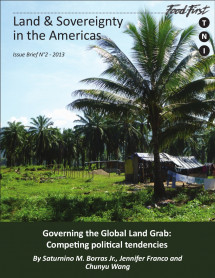Governing the Global Land Grab Competing political tendencies
The rise of flex crops—crops with multiple uses across food, feed, fuel and industrial complexes—has far-reaching implications for global land governance.

Authors
Reports of land grabbing from various parts of the world continue to come in: land grabbing for agriculture to produce food, feed, biofuels and other industrial products; “green grabbing” or land grabbing for environmental ends; and water grabbing for the irrigation of large-scale monocultures, hydroelectricity and other corporate uses. Understanding contemporary land grabs requires grasping the changing context in which they occur: the emergence of “flex crops”, the rise of BRICS and middle-income countries, and the revalued role of nation-states. This brief provides crucial context for understanding land grabbing and discusses three political tendencies in global land governance. In order for transnational movements to carry out more effective advocacy campaigns against land grabbing and influence global governance, they should understand these competing tendencies, and reassess and adjust their political framework.
This brief is the second in the Land & Sovereignty in the Americas series, co-published by Food First and the Transnational Institute.
About the series:
The Land & Sovereignty in the Americas series pulls together research and analysis from activists and scholars working to understand and halt the alarming trend in "land grabbing"-from rural Brazil and Central America to US cities like Oakland and Detroit- and to support rural and urban communities in their efforts to protect their lands as the basis for self-determination, food justice and food sovereignty.
The series - which includes short issue briefs and books - is a project of the Land & Sovereignty in the Americas (LSA) activist-researcher collective, coordinated by Food First.
For media inquiries about this series, or to arrange an interview with an author, please contact land@foodfirst.org or call +1 510 654-4400, ext. 2354.
Pages: 8

